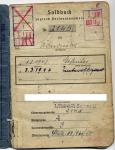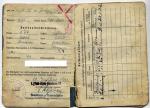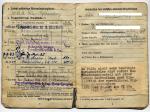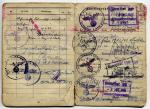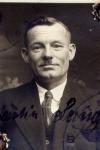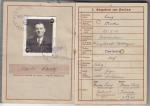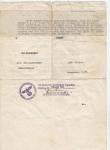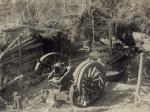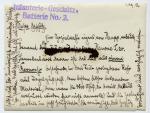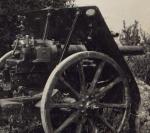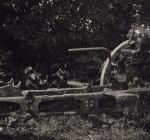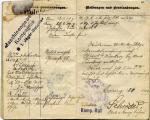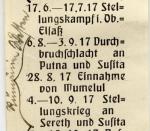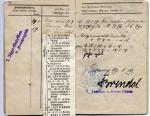-
Posts
4,312 -
Joined
-
Last visited
-
Days Won
4
Content Type
Profiles
Forums
Blogs
Gallery
Events
Store
Everything posted by Naxos
-
I recently acquired a Luftwaffe Soldbuch from an Unteroffizier of Sprachmittler-Abteilung der Luftwaffe. He was born 1909 in Saint Petersburg, Russia to a German aristocratic family, his father was a member of Tsar Nicholas' war cabinet. The man studied in Berlin before the war achieving a master's degree in economics. His profession is given as; Diplom-Volkswirt. He however, was enlisted as an ordinary soldier to a Flak unit in 1942. In October of the same year he was transferred to the Sprachmittler-Abteilung der Luftwaffe. In 1943 promoted to Gefreiter and awarded the "Wehrmacht-Dolmetscher Armbinde". He was then assigned to the Stab of the 12. Lufftwaffen-Feld-Division (later Division z.b.V. 300) and served in Kurland. In 1944 he was promoted to Unteroffizier. During his service he was awarded the KVKII and on April 20, 1945 the Kurland cuff title.
-
This, I believe, is one of those stories our late Rick L would have enjoyed. Gentlemen, let me introduce the little (153 cm / 5 foot) Bavarian stoker and farmer Martin Lang. Lang, born in a small Bavarian town near Ingolstadt in 1896, was recruited in 1916 to a Bavarian engineer battalion. During 1916 and 1917 he served in the Pionier-Park-Kompanie 14. He was trained as a locomotive/railroad engineer and in October 1917 transferred to the Feldbahn-Betriebs-Abteilung 11 where he piloted a steam locomotive until the end of the war. He never earned an award. His military record shows excellent (sehr-gut) behavior throughout his service. Only once he sustained an injury - November 11, 1918 - on Armistice Day the train engineer Martin Lang "passed-out" and fell against the train's boiler resulting in blisters to both of his hands. He was treated at a field hospital and released four days later. That was the "Great War", according to the surviving documents, for Martin Lang. . Fast forward to 1939 - We find Martin, now 43 years of age and still unmarried, recruited again. Again, as a regular grunt but this time with a Luftwaffe construction battalion. He saw a World War upfront and now in October 1939 he is witnessing it all happening again. The man that never had shown any sign of disobedience before had enough. According to witnesses - on October 29, 1939 the drunk Lw-Bau soldier Martin Lang went from table to table in a busy Bavarian pub calling the Fuehrer Adolf Hitler a dumbass, saying that Hitler, Goebbles and the others can kiss his a**. That the Fuehrer is an idiot and Hitler is the biggest dumbass ever. In January 1940, Lang was sentenced by a Luftwaffe court-martial to 3 weeks incarceration. He was subsequently discharged from the Wehrmacht for "health reasons". It appears Lang did survive the war but here we lose track of him again. Civil Courage! Okay, he was drunk ... but if only more would have had the courage to speak up, perhaps ... .
-
This little review, dated July 01, 1918, is written on the back of a photography depicting a field-gun, by an un-named gunner of Infanterie-Geschütz-Batterie Nr.2. He writes: Our gun. The L20 - 7,7cm infantry cannon is a weapon made by Krupp especially for infantry support. It has a barrel and breech that can be dismantled into three pieces with a core-barrel made of crucible steel (the best material it shows no wear from the 4500 rounds that went already through it). The entire gun can be disassembled into 6 main parts. This makes it possible to place the gun at the most impossible locations. This gun has proven itself dependable and most effective." Original German text: Infantrie-Geschütz-Batterie 2 Unser Geschütz Eine Spezialwaffe eigens von Krupp erbaut, benannt die 7,7cm Infanterie Kanone L20.Bemerkenswert daran ist das der aus einem Kernrohr bestehende, in drei Teile zerlegbare Rohr, aus Tiegelgussstahl – dem besten bisher bekannten Material – dem man die 4500 Schuss, die bereits daraus verfeuert wurden, gar nicht anmerkt und die Zerlegbarkeit in sechs Hauptteile die ermoeglicht das Geschutz selbst auf die unmoeglichst erscheinenden Plaetze zu stellen. Das Geschütz hat sich als auserst brauchbar und vorzueglich bewiesen. and here is the pride and joy of IGB2 Details of the L20 http://gmic.co.uk/uploads/monthly_01_2015/post-1062-0-09411500-1421722047.jpghttp://gmic.co.uk/uploads/monthly_01_2015/post-1062-0-25547400-1421722068.jpghttp://gmic.co.uk/uploads/monthly_01_2015/post-1062-0-35957500-1421722009.jpg .
-

Unknown Schlaufe Purpose
Naxos replied to Chip's topic in Germany: Imperial Uniforms, Headwear, Insignia & Personal Equipment
Chip, I believe it is split "zum einknöpfen" of something - the split acts like a button hole at the bottom of the strap. -
On July 20, 1916 he was sent to the front to serve in the second company of the Bavarian 1.Jäger-Bataillon His long list of engagements start on July 21, 1916 at Fleury and end on Nov.01, 1918 in Serbia. He was awarded the Iron Cross second class on March 16, 1917 a month before his 20th birthday. In May 1917 he received the Bavarian Military Merit Cross third class. He served from July 20, 1916 to January 12, 1919 in the 2nd company of the Bavarian 1.Jäger-Bataillon Engagement list



